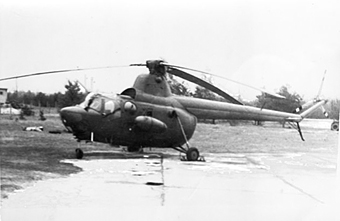
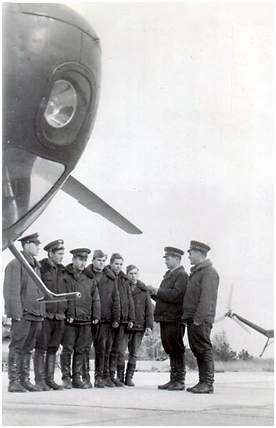 Un escadron de reconnaissance et de correction d'artillerie volant
sur Mi-1KR fut basé à Sperenberg à partir de 1960. © Collection L.Khandurin.
Un escadron de reconnaissance et de correction d'artillerie volant
sur Mi-1KR fut basé à Sperenberg à partir de 1960. © Collection L.Khandurin.
A reconnaissance and artillery
correction Mi-1KR squadron was based at Sperenberg from 1960 on. © L.Khandurin collection.
It seems logical that the Mi-2 succeeded the Mi-1 in the GDR and that there probably were more of them. However, precisely tracing the "Hoplite" period in
East Germany is simply impossible. All we know for sure is that they equipped the units of the OVO, OVE OP and OVE BU type.
See > 4.1 The Armeyskaya Aviatsiya in Germany.
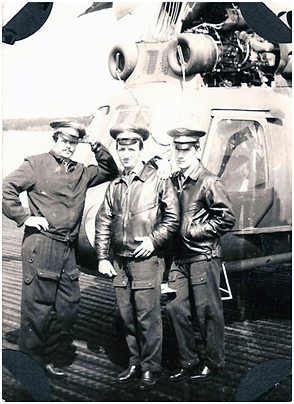 L'équipage d'un Mi-2
à Mahlwinkel en 1974. © Collection K.Kirillov.
L'équipage d'un Mi-2
à Mahlwinkel en 1974. © Collection K.Kirillov.
The crew of a Mi-2 at Mahlwinkel in 1974.
© K.Kirillov collection.
The V-2 prototype, powered by two GTD-350 400-hp gas turbines (the Mi-1 used the single Ivchenko AI-26 575-hp piston engine), made its first flight September 22, 1961.
In 1965, the WSK Swidnik Factory in Poland began mass production of the Mi-2 that replaced the Mi-1 on the production lines. Several variants were developed, including
armed versions that were essentially operated by the Polish armed forces. The V-2V model (V for Vooruzhennyy - Armed) designed in 1965 by the Mil' Experimental
Design Bureau (OKB) could carry six 9M17 Falanga (AT-2 "Swatter") anti-tank missiles or four UB-16-57UV 16-shot rocket pods. However, this machine was not
subjected to military assessments before the early seventies and interest for this Mi-2 modification faded away upon entry of the Mi-24 "Hind" into service.
In addition to the basic Mi-2T used for liaison flights and transportation in the GDR, some helicopters had additional radio equipment (see this
picture), suggesting
that they fulfilled the role of light airborne command post. As was the case with the Mi-1, other specialized versions of the Mi-2 undoubtedly also served in the ranks
of the GSFG. One of these was the Mi-2KhR (Chemical Reconnaissance).
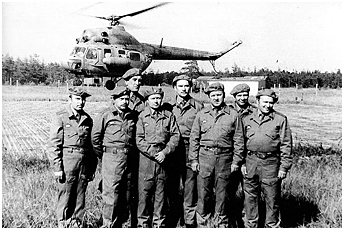
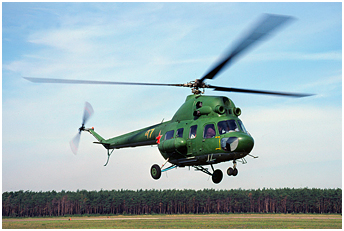 Thus, according to Vladimir Geyzatulin, a Mi-8 pilot assigned to the 113th Separate Composite Aviation Squadron (OSAE) (1)
based at Sperenberg, the predecessors of
this unit' Mi-24R "Hind-G1" NBC reconnaissance helicopters were none other than Mi-2s - therefore most likely of the KhR variant. As for the Mi-2KR reconnaissance and artillery
adjustment variant that began flight tests in 1974, it seems that this version suffered the same fate as the prototype V-2V. However, if we consider that at least one Mi-1KR squadron
was based at Sperenberg during the 1960s, it is conceivable that the Mi-2KR succeeded the "Hare" reconnaissance and artillery adjustment variant in the GDR. The Mi-2KR already
employed a version of the Ruta reconnaissance suite (see > 4.2 The Mi-24 "Hind" ).
Some Mi-2U (U for Uchebnyy - Training) were also in use with the GSFG. It should be stressed that, after helicopter build number 1623, all Mi-2 utility birds easily
could be modified into training variants equipped with dual controls. A Mi-2 in such a configuration could be quickly identified thanks to the small 5-kg lead counterweight attached
to the tailboom skid. The Mi-2 of the GSFG were maintained at Rangsdorf, as also was the case for the Mi-8.
Thus, according to Vladimir Geyzatulin, a Mi-8 pilot assigned to the 113th Separate Composite Aviation Squadron (OSAE) (1)
based at Sperenberg, the predecessors of
this unit' Mi-24R "Hind-G1" NBC reconnaissance helicopters were none other than Mi-2s - therefore most likely of the KhR variant. As for the Mi-2KR reconnaissance and artillery
adjustment variant that began flight tests in 1974, it seems that this version suffered the same fate as the prototype V-2V. However, if we consider that at least one Mi-1KR squadron
was based at Sperenberg during the 1960s, it is conceivable that the Mi-2KR succeeded the "Hare" reconnaissance and artillery adjustment variant in the GDR. The Mi-2KR already
employed a version of the Ruta reconnaissance suite (see > 4.2 The Mi-24 "Hind" ).
Some Mi-2U (U for Uchebnyy - Training) were also in use with the GSFG. It should be stressed that, after helicopter build number 1623, all Mi-2 utility birds easily
could be modified into training variants equipped with dual controls. A Mi-2 in such a configuration could be quickly identified thanks to the small 5-kg lead counterweight attached
to the tailboom skid. The Mi-2 of the GSFG were maintained at Rangsdorf, as also was the case for the Mi-8.
The Mi-2s still present in Germany at the time of reunification were survivors, because the "Hoplite" was withdrawn from service from 1987 on. It had progressively vanished from
all OVE OP and most OVE BU. While some were repatriated to the Soviet Union or destroyed on site, a few found refuge locally in places such as kindergartens. At the end of 1992, the last
"Hoplite" still operational with the WGF (2) were gathered at Werneuchen from where they finally departed to Russia
on March 24, 1993. Apparently, a first group of at least five helicopters equipped with an additional fuel tank in the cargo compartment had already left Germany on December 3, 1992.
They were indeed observed and photographed heading north, separated at five-minute intervals, from a French Alouette III of the DETALAT from Berlin-Tegel when they were in the
Eberswalde area (see the Mi-2 photo gallery).
| Mi-2 interceptor... On April 23, 1980, a grey Cessna 182G 'Skylane' bearing D-EKWR registration crossed the border between the FRG and the GDR at 15H39 near Großburschla, which is about 25 kilometers northwest of Eisenach. At precisely 16H11, the unlucky lost pilot's aircraft was intercepted by a Mi-2 helicopter sent to meet it and forced to land at Schlotheim Airfield, probably the base from which the "Hoplite" originated. That was probably the only time that a Mi-2 was given the opportunity to intercept an aircraft! From http://skywar.ru and http://home.snafu.de/veith/Texte/Chronik-der-Luftstreitkraefte.pdf |
notes
(1)
1978-1982 and 1991-1994 period.
(2)
298.OVE BU at Hassleben and 41.OVE BU at Werneuchen.
 |
Mi-2 PHOTO PAGE |  |
 |
Plan du site - Sitemap |  |

